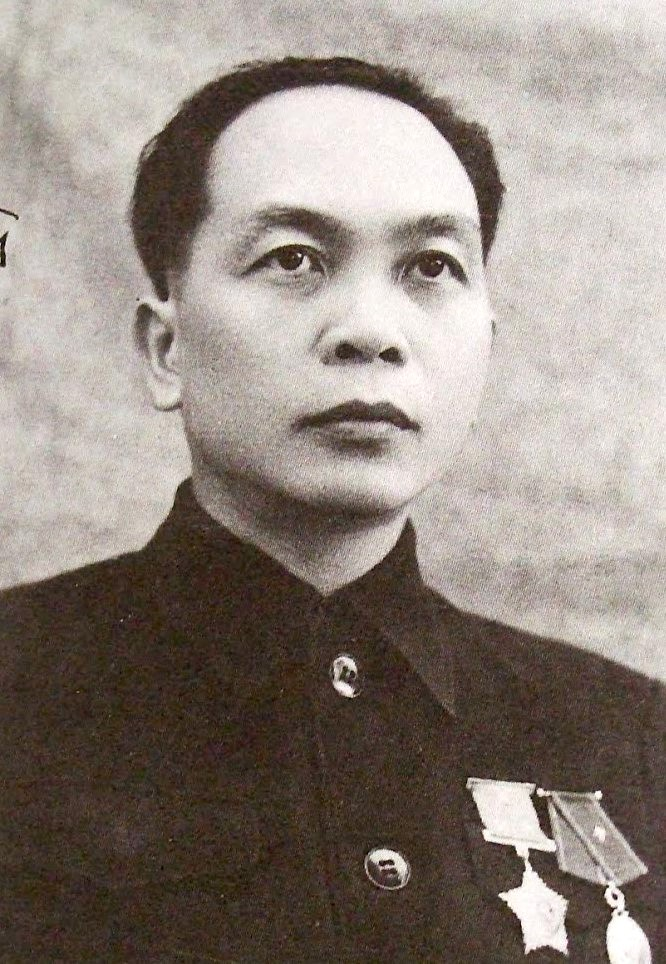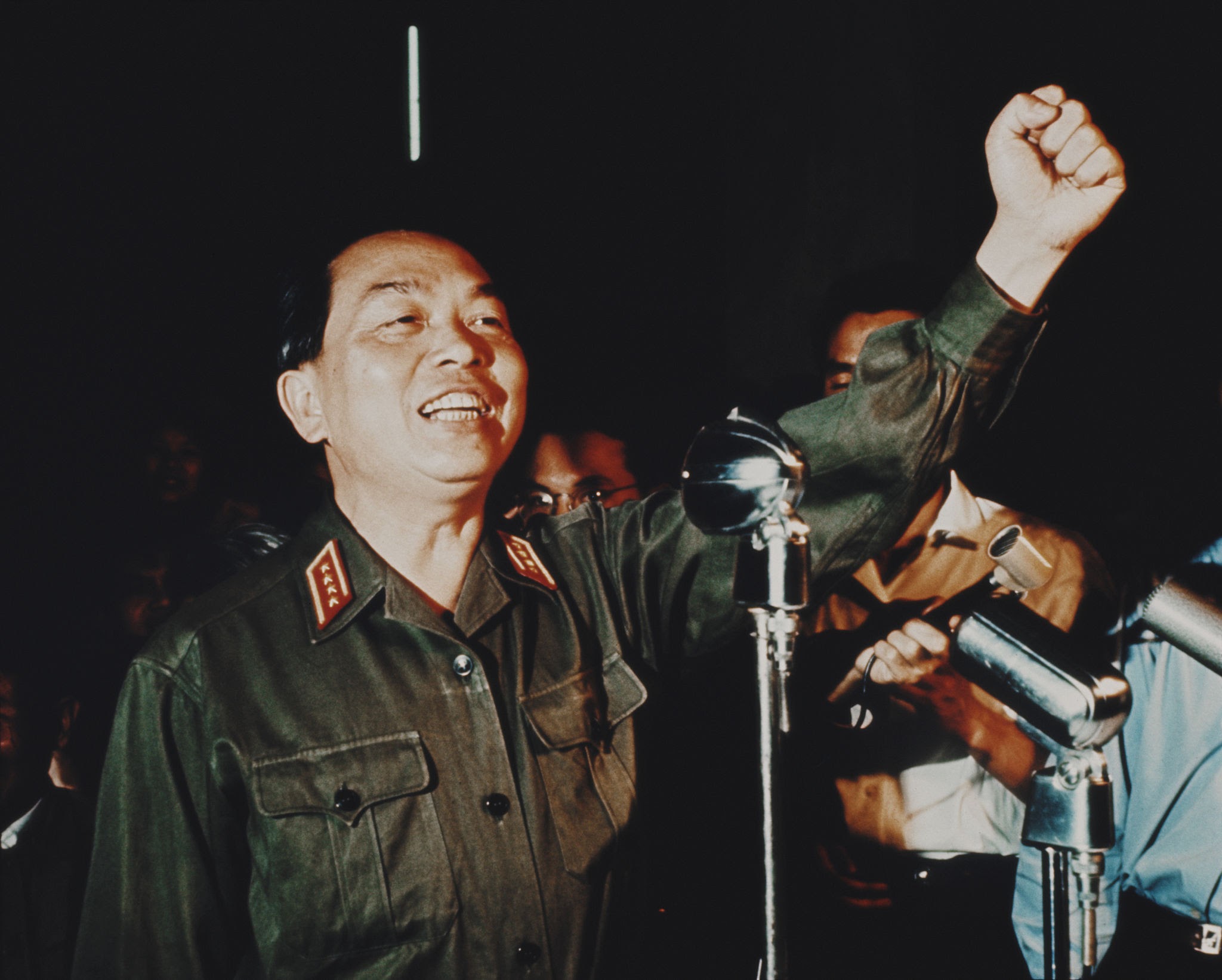More languages
More actions
No edit summary Tag: Visual edit |
(Minor edits and tweaks) Tag: Visual edit |
||
| Line 1: | Line 1: | ||
{{Infobox politician|name=Võ Nguyên Giáp|image_size=200|birth_date=25 August 1911|death_date=4 October 2013|death_place=Hanoi, [[Vietnam]]|birth_place=Lệ Thủy, Quảng Bình, [[Indochinese Union (1887–1954)|French Indochina]]|nationality=Vietnamese|political_line=[[Marxism–Leninism]]<br>[[Ho Chi Minh Thought]]|image=Vo Nguyen Giap.png}} | {{Infobox politician|name=Võ Nguyên Giáp|image_size=200|birth_date=25 August 1911|death_date=4 October 2013 (aged 102)|death_place=Hanoi, [[Vietnam]]|birth_place=Lệ Thủy, Quảng Bình, [[Indochinese Union (1887–1954)|French Indochina]]|nationality=Vietnamese|political_line=[[Marxism–Leninism]]<br>[[Ho Chi Minh Thought]]|image=Vo Nguyen Giap.png}} | ||
'''Võ Nguyên Giáp''' was a Vietnamese [[Communism|communist]] general and politician. He fought in the wars against [[Empire of Japan (1868–1947)|Japan]], [[French Republic (1946–1958)|France]], and the [[United States of America|United States]]. | '''Võ Nguyên Giáp''' was a Vietnamese [[Communism|communist]] general, theorist and politician. He fought in the wars against [[Empire of Japan (1868–1947)|Japan]], [[French Republic (1946–1958)|France]], and the [[United States of America|United States]]. | ||
== Early life == | == Early life == | ||
| Line 15: | Line 15: | ||
=== Resistance War against the United States === | === Resistance War against the United States === | ||
[[File:General Giáp.jpg|thumb|General Giáp in 1969]] | |||
On 17 June 1954, the United States divided Vietnam along the 17th parallel and installed a [[Republic of Vietnam (1955–1975)|puppet state in the south]] led by Japanese collaborator [[Bảo Đại]]. The Geneva Convention planned to elect a president for reunified Vietnam two years later, but the United States did not allow the election to take place because Ho Chi Minh would win. Giáp used the Ho Chi Minh Trail to supply communist forces in the south. By 1963, there were over 16,000 U.S. troops in Vietnam. The United States sent more troops after President [[Lyndon B. Johnson]] claimed that North Vietnamese forces attacked a U.S. navy cruiser in the Gulf of Tonkin.<ref name=":0" /> In 1968, Giáp directed thousands of soldiers to attack 35 strategic centers in the south in the [[Tet Offensive]].<ref name=":1" /> | On 17 June 1954, the United States divided Vietnam along the 17th parallel and installed a [[Republic of Vietnam (1955–1975)|puppet state in the south]] led by Japanese collaborator [[Bảo Đại]]. The Geneva Convention planned to elect a president for reunified Vietnam two years later, but the United States did not allow the election to take place because Ho Chi Minh would win. Giáp used the Ho Chi Minh Trail to supply communist forces in the south. By 1963, there were over 16,000 U.S. troops in Vietnam. The United States sent more troops after President [[Lyndon B. Johnson]] claimed that North Vietnamese forces attacked a U.S. navy cruiser in the Gulf of Tonkin.<ref name=":0" /> In 1968, Giáp directed thousands of soldiers to attack 35 strategic centers in the south in the [[Tet Offensive]].<ref name=":1" /> | ||
Revision as of 19:29, 30 August 2023
Võ Nguyên Giáp | |
|---|---|
 | |
| Born | 25 August 1911 Lệ Thủy, Quảng Bình, French Indochina |
| Died | 4 October 2013 (aged 102) Hanoi, Vietnam |
| Nationality | Vietnamese |
| Political orientation | Marxism–Leninism Ho Chi Minh Thought |
Võ Nguyên Giáp was a Vietnamese communist general, theorist and politician. He fought in the wars against Japan, France, and the United States.
Early life
Giáp was born in 1911 in an educated peasant family. His father died in prison in 1919 after participating a rebellion against the French. His older sister also died shortly after being released from prison. He joined the New Vietnam Revolutionary Party in 1924, where he became a communist. He was imprisoned for 13 months in 1930 and joined the Communist Party of Vietnam after being released,[1] quickly becoming friends with Ho Chi Minh.[2] He studied law from 1933 to 1938 at Hanoi. He left for China in 1940 after French authorities banned the CPV.[1]
Military career
Second World War
In September 1940, fascist Japan occupied Vietnam. Giáp moved to the mountains in 1941 to begin a guerrilla resistance[2] and formed the Viet Minh army in 1942, which later became the People's Army of Vietnam. By mid-1945, he had gathered 10,000 troops and began offensive attacks against the Japanese.[2] In August 1945, Japan surrendered, and Ho Chi Minh ordered the Viet Minh to begin a revolution against French colonial rule.[1]
Anti-French Resistance War
The Democratic Republic of Vietnam was founded in 1945 and declared war against France in December 1946.[1] In an attempt to make Giáp surrender, the French sentenced his wife to life in prison and executed several of his family members.[2] The Viet Minh received heavy weapons and military advisors from the People's Republic of China after the end of the Chinese Civil War. In 1953, the French established a base at Điện Biên Phủ near the border with Laos. Giáp and his troops carried artillery through the mountains and fired on the French, who had not known that the Vietnamese had heavy weapons. France surrendered on 7 May 1954.[1]
Resistance War against the United States

On 17 June 1954, the United States divided Vietnam along the 17th parallel and installed a puppet state in the south led by Japanese collaborator Bảo Đại. The Geneva Convention planned to elect a president for reunified Vietnam two years later, but the United States did not allow the election to take place because Ho Chi Minh would win. Giáp used the Ho Chi Minh Trail to supply communist forces in the south. By 1963, there were over 16,000 U.S. troops in Vietnam. The United States sent more troops after President Lyndon B. Johnson claimed that North Vietnamese forces attacked a U.S. navy cruiser in the Gulf of Tonkin.[1] In 1968, Giáp directed thousands of soldiers to attack 35 strategic centers in the south in the Tet Offensive.[2]
Military theory
Giáp defined people's war as a war by and for the people. He believed that a successful people's army needed the leadership of a communist party, strict discipline, and a political line consistent with the material conditions of the country.[2]
References
- ↑ 1.0 1.1 1.2 1.3 1.4 1.5 Jack Smith (2013-10-12). "Remembering Gen. Giap" Liberation School. Archived from the original on 2020-09-22. Retrieved 2022-08-28.
- ↑ 2.0 2.1 2.2 2.3 2.4 2.5 "On the 100th birthday of the legendary General Vo Nguyen Giap" (2011-08-26). Liberation News. Archived from the original on 2019-07-14. Retrieved 2022-12-17.
